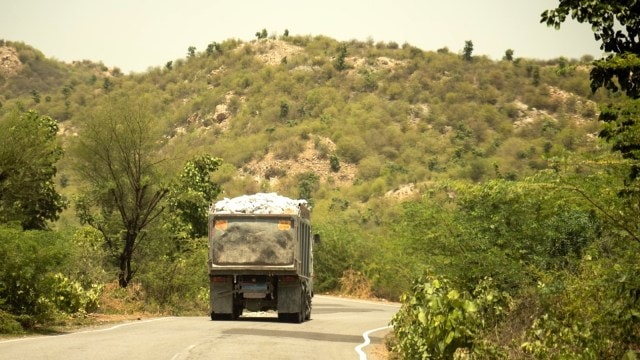A plan drawn up to rationalise the boundary of Sariska Tiger Reserve’s Critical Tiger Habitat (CTH) may offer a lifeline to over 50 marble and dolomite mines that were closed following a Supreme Court order last year due to their proximity to the CTH.
If notified as proposed, the new CTH boundaries will retreat in multiple stretches, putting these mines outside the one-kilometre zone from the boundary, where mining and other activity is prohibited.

The Rajasthan government’s proposal has identified mostly hilly parcels, adding up to 48.39 sq km, as “peripheral degraded areas affected by human activities” that can be excluded from the CTH. To compensate, 90.91 sq km of “quality tiger habitat” in the Sariska buffer will be added to the CTH.
“These areas moved from the CTH to the buffer will not be part of the sanctuary or national park. This conversion will help foster cordial relations between the local community and the tiger reserve management,” the proposal said.
However, two senior Rajasthan forest officers who served in Sariska said that excluding these peripheral hills would cut off the tiger reserve’s internal connectivity.
“The geometry is such that Sariska stands on two asymmetrical legs in the south. The finger-shaped hills are not dispensable, but vital for tiger movement between these two segments,” one of the officers said.
Asked about these concerns, Rajasthan’s Head of the Forest Force (HoFF), Arijit Banerjee, said: “Only areas that cannot be salvaged are left out. The boundary rationalisation exercise will make the tiger reserve management more effective on the ground.”
Story continues below this ad
 ‘Rationalising’ Sariska boundaries
‘Rationalising’ Sariska boundaries
Double-engine push
Sources in Alwar and Jaipur said the Rajasthan government is working to get the proposal tabled at the state wildlife board meeting on Monday, just in time for it to be taken up by the Standing Committee of the National Board of Wildlife (SC-NBWL), which is scheduled to meet in Dehradun on June 26.
The SC-NBWL’s meeting was originally scheduled for June 11. It was deferred, according to sources, to take up the Sariska CTH proposal before it is placed before the Supreme Court for final clearance.
Rajasthan had declared 881 sq km of land as the CTH for Sariska in 2007-08, but the notification remained pending due to multiple disputes over the legal status of certain land parcels.
Story continues below this ad
“This (rationalisation) has been a contentious issue. But this time, as both ministers (the state Forest Minister and the Union Environment Minister) are from Alwar, there is a double-engine drive to get it done. We have been working overtime to double-check the finer details,” said a senior revenue official, who was part of the 12-member committee constituted by Rajasthan for drafting the proposal.
Rajasthan Forest Minister Sanjay Sharma is the MLA from Alwar (Urban), while Union Environment Minister Bhupender Yadav was elected from the Alwar Lok Sabha constituency.
 A marble mine next to Sariska boundary near Palpur. (Express photo)
A marble mine next to Sariska boundary near Palpur. (Express photo)
On the ground
Of the 100 marble, dolomite, limestone and masonic stone quarries around Sariska, 43 had already been non-operational due to a lack of permits and other reasons, while 57 active mines were closed under the Supreme Court order last May.
Story continues below this ad
The Indian Express has seen idling machinery and workers at a number of these mines that have been closed, on paper, for over a year due to their proximity to the CTH.
A majority of these mines dot the southern periphery of Sariska in Tehla tehsil, which accounts for 77% (37 sq km) of the area identified to be left out of the CTH.
A field assessment backed by local sources indicated that the proposed CTH boundaries will put over 50 of these mines — 27 around village Khoh, six around village Palpur, four each around villages Tilwad, Gordhanpura and Mallana, three around village Doondpuri, two around village Jaisinghpur and one near village Kalwar — beyond the one-km no-mining zone.
This may also bring relief to a couple of mines on Sariska’s western boundary in Pratapgarh tehsil.
Story continues below this ad
Local mine owners The Indian Express spoke to put the annual revenue from the Tehla mines alone at Rs 700-800 crore, with a profit range of Rs 500-600 crore.
“Dolomite lumps are more profitable than marble due to cheaper extraction cost — around Rs 175 per tonne — and sell for Rs 750-900. Tehla mines used to send out at least 1,000 trucks daily for 10 months a year. At a minimum of 30 tonnes per truck, that one tehsil is worth at least Rs 500 crore annually,” said the owner of an operational mine a few kilometres from Sariska.
Charges of corruption
There have also been allegations of corruption. K S Rathore, the owner of a dolomite mine in Thanagazi, alleged in a complaint sent to the Prime Minister’s Office on June 14 that owners of several of the closed mines were asked to pool money to get their mines operational again.
“My mine is legal and yet they keep demanding money. I put my business at stake to write that letter. Does anyone think it’s a coincidence that the (CTH) boundary is finally being redrawn, and all these mines are getting relief? I hope the PMO takes note,” Rathore told The Indian Express.
Story continues below this ad
Sangram Singh Katiyar, the field director of Sariska Tiger Reserve, denied that the boundary demarcation process was influenced by mining stakeholders. He also said he was not aware of Rathore’s allegations.
“There are a few mining areas in the list of exclusion, but the demarcation process was not influenced by such stakeholders. We have followed expert advice from the point of view of tiger conservation to prepare the report under the SC order,” Katiyar said.
CEC report
The Supreme Court order in question came in a suo motu case regarding the issues of unrestricted entry of people on foot and private vehicles inside Sariska Tiger Reserve. In March 2024, the court asked its Central Empowered Committee (CEC) to submit a report on the issue.
Reconstituted in September 2023 under the Environment ministry, the CEC expanded the scope of the report by including other issues such as village relocation, cattle grazing, staff strength and boundary demarcation.
Story continues below this ad
The issue of mining, however, was only mentioned once in the CEC’s 79-page report: “The illegal mining activities are because of the poor demarcation.”
After Rajasthan accepted the CEC’s July 2024 report in September, the Supreme Court asked the state in December to complete the boundary rationalisation process within a year, subject to its final approval.
Asked why the CEC expanded the scope of its report, a member who spoke on condition of anonymity said the committee wanted to “resolve all contentious issues, including boundary rationalisation, that have been pending for too long”.
“We are hopeful that the CTH will be finalised before the Supreme Court deadline as the honourable minister is personally supervising the matter,” the CEC member said.
Story continues below this ad
CEC chairman and former DG (forest) of the Environment Ministry, Siddhanta Das declined to comment, saying the committee was “not supposed to speak” to the media.



 ‘Rationalising’ Sariska boundaries
‘Rationalising’ Sariska boundaries A marble mine next to Sariska boundary near Palpur. (Express photo)
A marble mine next to Sariska boundary near Palpur. (Express photo)





